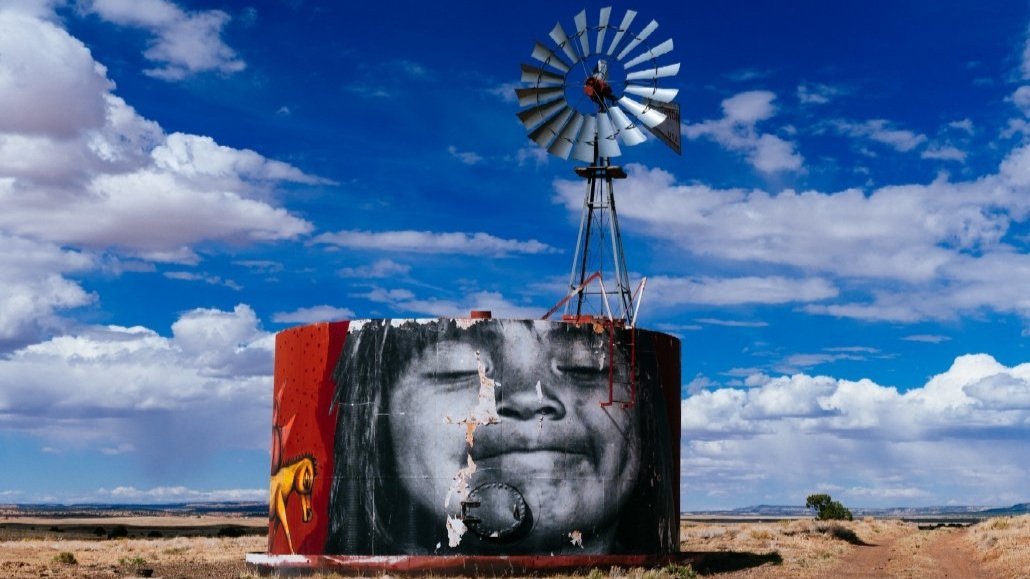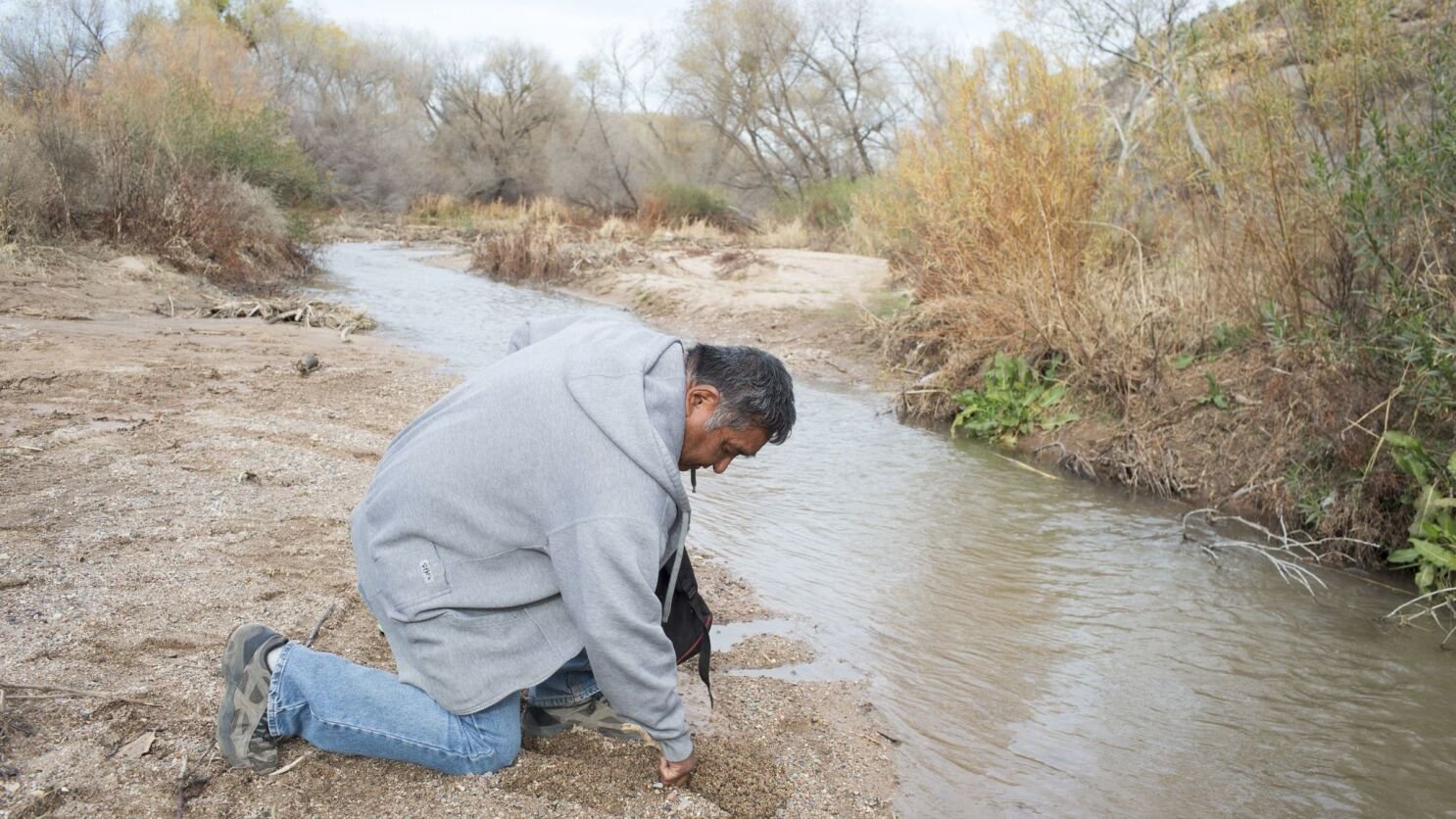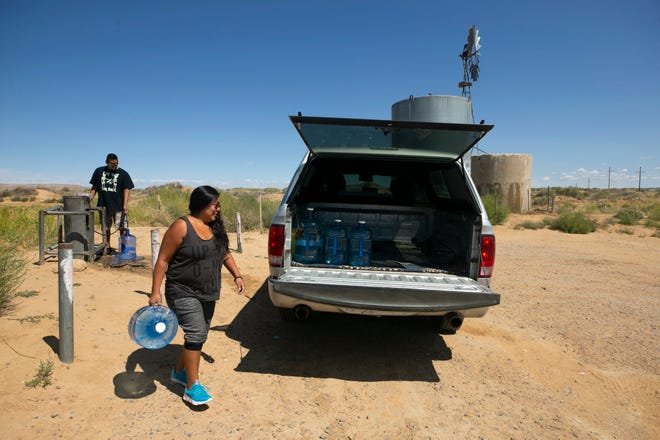Indigenous Water
Examining the Existing Disparities in Water Rights for Indigenous Peoples
Max Taylor, of the Hopi Reservation, using manual pump that serves the entire community © David Wallace/ The Republic
Context
Phoenix & Surrounding Indigenous Communities
Greater Phoenix recognized indigenous tribal lands:
Gila River Indian Community
Salt River Pima-Maricopa Indian Community
Ak-Chin Indian Community
Tohono O’odham
Indigenous History
In what is today known as central Arizona, the indigenous O'odham and Piipassh peoples have occupied the land for well over 2,000 years, both originating from the Hohokam people. Today, the four main reservations are the Gila River Indian Community, Salt River Pima-Maricopa Indian Community, Ak-Chin Indian Community, and the Tohono O’odham Nation. With the rise of Spanish and American colonialism taking more land in the region throughout the late 17th-19th centuries, O’odham and Piipash tribal members were forced to perpetually migrate. The indigenous groups become more concentrated in the Salt lake river area while increasing conflict with other indigenous groups, reservation boundaries continue to displace tribal members, and colonizers would periodically restrict river water flow to the indigenous communities. Water access in Arizona today has been used as leverage to systematically oppress and murder O’odham and Piipash people for centuries, today with a more conspicuous, modernized approach.
Modern Context
Today, there approximately 22 sovereign nations across the state of Arizona. Sovereignty means that each nation is responsible of self-governing. Each tribe has its own government, just like the US. One of the most important issues Arizona faces is water equity. For hundreds of years, tribal, federal, and state governments have been clashing over water rights. We’re taking a closer look at the given water rights for sovereign tribal nations and comparing them to the US city of Phoenix.
The Current Water Issues
Based on the amount of personal testimonies about certain issues. Weighted by population.
Timeline of AZ, Phoenix, and the Indigenous Community
The “founding” and current population growth timeline for the city of Phoenix
1881
Area: .5 Sq Mi
Population: 1,708
1950
Area: 17.1 Sq Mi
Population: 106,818
1970
Area: 248 Sq Mi
Population: 584,303
1990
Area: 424.6 Sq Mi
Population: 983,403
2010
Area: 519.1 Sq Mi
Population: 1,451,966
Made by Planning and Development Department Information from (1) US Census Bureau. "1880 through 2010 Census Data." Washington D.C. April 1, 2010. (2) City of Phoenix City Clerk Department. "Area in Square Miles." Phoenix, Arizona. March 2011. (3) Arizona Department of Administration. "Population Estimate for July 1, 2011." Phoenix, Arizona. December 15, 2011.
Connection of Different Water Treaties, Projects, and Rights
Scroll over the different nodes to see the name of the event and its agreement classification.
The Water Sources of Phoenix
2020. Tohono people exchanging water vessels at the U.S.-Mexico border that separates their tribal land.
Today, within city lines, Phoenix is a thriving community filled with many amenities for its inhabitants
To the left, you can see bus stops, bus routes, parks, and city-owned land
Where the water comes from
There are many sources of water near Phoenix, to the right you can see rivers, canals, pipelines, and wells.
North & South Phoenix
The Phoenix water supply is spilt into two zones: North Phoenix and South Phoenix. Both receive their water supply from different sources, with different effectiveness.
Water Usage
Current annual water usage in acre-feet of Phoenix and the surrounding native lands. Though Phoenix uses a substantial larger amount of water, it does have a much large population size.
Population: Phoenix-1,633,000 ; Ak-Chin- 1,348; Gila River Indian Community- 11,150; Salt and River Pima Maricopa Indian Community- 7,386; Tohono Oodham Nation- 10,223
Scaling Up: Water (Or Lack Thereof) Flows Beyond Borders
A water tank on the Navajo Nation. Photo courtesy of Flickr/Creative Commons user CEBImagery. Mural by Jetson Orama.
Tommy Rock fills water jugs for his family home, 15 miles away, while others line up for their turn in the community of Goulding, Utah, waiting for about an hour. Many families in this part of the Navajo Nation live in homes without running water. Photograph: Nick Oza/The Republic
Darlene Yazzie typically hauls water from a windmill 5 miles from her house for her sheep. Officials tell her it's unsafe for humans but OK for livestock. Photograph: Laurel Morales/KJZZ
Amanda Larson, who has no running water at her home, carries water for her son to have a bath in the Navajo Nation town of Thoreau, NM last year. Photograph: Mark Ralston/AFP/Getty Images
A Day in the Life: Navajo Nation & Water
1 in 10 Indigenous Americans lack safe drinking water access
As of today, 1 in 3 Navajo homes live without any running water
Indigenous households. are 19 times more likely to lack indoor plumbing in the U.S.
Navajo Nation members are 67 times more likely to live without running water than any other group in the U.S.
The cost of hauling water is at least 70 times more expensive than piped water
Accessing Drinking Water
Typically, many Navajo Nation residents must either drive or walk to the nearest, functional water pump or water tanker delivery to hopefully fill up enough jugs for their families
Occasionally, cases of bottled water will be donated to residents by emergency, “border-crossing” non-profits
Pumping water is a process that requires resources that many homes do not have access and community assistance is vital
During the Day
Not only do most residents lack access to drinking water, but daily, normative activities, such as bathing, cooking, cleaning, are extremely cost and time consumptive - among other things
Hygiene facilities offering residents showers cost an average of $6 per shower - not considering travel
Many Diné people run agricultural or livestock farms, both of which demands copious amounts of water
Hardships and Issues
Beyond water scarcity, access to basic health care, grocery stores, and other vital infrastructural amenities are dilapidated, rare, or non-existent for the largest Indigenous Tribe in the U.S.
“Tó éí ííńá át’é (water is life)”
Looking For a Solution
“On an Apache Reservation in Arizona, a Toxic Legacy and a Mysterious History of Chemical Spraying.” Los Angeles Times, Los Angeles Times, 19 Jan. 2017
Hopi Reservation members filling up water jugs for drinking water from a communal well
Water Inequity Among Indigenous Communities
One of the issues is the differences in Western and Native ideologies over water. In Native culture water is a source of life, something to be cared for and maintained, a responsibility. In western culture, water is thought of and treated as a commodity. Specifically in the USA, due to the western takeover of the country starting with colonization and continuing to the current day, water has turned into a commodity, something to be bought and sold. This contrasts greatly with the philosophy of the indigenous peoples of the country who view water as necessary for life and therefore belonging to everyone in addition to being a responsibility for everyone to take care of.
This is a common narrative throughout the world. In Aotearoa New Zealand during colonization, the Māori groups and the existing ruling government signed the Treaty of Waitangi/Tiriti o Waitangi which acknowledged and established native rights over lands and water. This treaty was not upheld and large amounts of land and water were taken from natives turning the areas into farms, urban centers, and industrial centers. As a result, the entire landscape changed, including decreasing biodiversity and decreasing the quality of water.
This continued until about 2010 where a legal treaty was signed creating a partnership between the New Zealand government and the Maori groups which made provisions for the Maori to co-govern and co-manage water sources and certain lands such as parks. “Importantly, new legislation recognizes and enables the inclusion of Māori knowledge (mātauranga), values and principles to transform water governance” leading to greater indigenous control of water management and decisions. This attempts to combine both western and native ideologies to create a hybrid system of managing water. This requires great collaboration between both sides, currently, there is no conclusive evidence as to the effects of this due to the recent nature of the treaty.
Parsons, Meg, and Karen Fisher. “Indigenous Peoples and Transformations in Freshwater Governance and Management.” Current Opinion in Environmental Sustainability, Elsevier, 28 Apr. 2020, https://www.sciencedirect.com
The Current State of Water Equity
Currently, the Chemehuevi, Mohave, Hopi, and Navajo tribes are trying to do something similar with their water in Arizona. They are proposing to lease the water rights of the Colorado River in exchange for money to provide resources for education, healthcare, and law enforcement. The tribes have the largest allocation of water out of any group with 662,000 acre-feet in Arizona and 56,000 acre-feet in California (combined that’s 889,000,000,000 liters of water). Most of this water goes unused however due to current federal laws, tribes are not allowed to lease or sell their water and so that unused water does in fact get used by other communities without compensation. This applies to tribes who already have resolved water rights (7 out of 22 tribes). There are still a number of tribes that don’t include Havasupai Tribe, Hopi Tribe, Hualapai Indian Tribe, Kaibab Band of Paiute Indians, Navajo Nation, Pasqua Yaqui Tribe, San, Juan Southern Paiute, Tonto Apache Tribe, Yavapai-Apache Nation. There are plenty of others who only have partially resolved water rights. Those with no rights and only partial rights will be the first to face water cutbacks due to their lack of funding, infrastructure, and legal allocation of water. Even those with rights still face similar issues where the lack of infrastructure and their inability to lease their water leaves them without the necessary resources to even use the water they own. Technically, all tribes are entitled to enough water to address all on reservation needs however without the proper infrastructure this water is unattainable.
Due to decreasing levels of water in the Lake Mead basin, there are reductions being made to water access throughout California and Arizona. Indigenous tribes who have water rights will be the last ones required to institute reductions due to their vast amount of water ownership, specifically until there is a tier 3 shortage announced. After this as water levels diminish this poses a threat to the electricity production coming from the Hoover Dam hydroelectric plant.
“Arizona Tribe Proposes Law to Lease Its Water Rights.” AP NEWS, Associated Press, 11 Dec. 2020, https://apnews.com/article/arizona-droughts-native-americans-water-rights-lake-havasu-city-6573264445495e8a82b73878e9fbf758.
“Tribal Water Rights.” Central Arizona Project, 31 May 2021, https://www.cap-az.com/about/tribal-water-rights/.
“The Colorado River Is Drying up. Here's How That Affects Indigenous Water Rights.” Grist, 5 Oct. 2021, https://grist.org/equity/colorado-river-drought-indigenous-water-rights/.
There is a prevailing lack of Water Security Among Indigenous Communities
Currently, most tribes and nations are scoring between an 8 and a 10, meaning that they have some access to water it’s just not reliable or of quality. The criteria for these numbers come from 4 areas:
Legal Water Rights Status (Full, Partial, None)
Infrastructure Level (None-Adequate)
Refers to the amount of water based infrastructure available to the tribe/nation (ex. wells, water recycling plants, canals, reservoirs, etc.)
Economic Ability (None-Plenty)
Refers to the economic activities that take place in that tribe/nation (ex. agriculture, shopping, tourism, gaming, selling water, etc.)
Population (Weighted grade based on actual number)
Most tribes and nations are lacking in the water rights and infrastructure categories with only 6 out of 22 tribes have full legal rights and the majority of reservations having access only to water wells (a lot of which have contamination issues). In order to have all of the tribes in an area of good/adequate water security (about a 13), there needs to be a series of changes and reforms.
The Water Equity Crisis in the South West Requires a Series of Solutions
Water Rights Revision: The existing indigenous tribes in the area need to have their water rights recognized and respected. This includes resolving partial water rights and allocating water for tribes currently having no recognized rights.
Policy Revision: Allow nations and tribes with water rights to do as they wish with their water such as leasing that water to neighboring communities for capital gain.
Infrastructure Build-Up: A lot of nations and tribes don’t have the proper infrastructure in order to use the water they have rights too. Investing capital and resources into better water infrastructure for the entire state can help with the water crisis and equity issue concerning the whole population of Arizona. There are already a series of canals and a pipeline that delivers water to big urban areas such as Phoenix, this can be expanded on to be used to better deliver water to the whole region. Additionally, the building of more water recycling systems and water treatment centers can help decrease the amount of water being siphoned from the Colorado, Salt, and Verde Rivers, and provide water for communities who need it.
Water Rights Resolution
Policy Revision
Infrastructure Build-Up
















